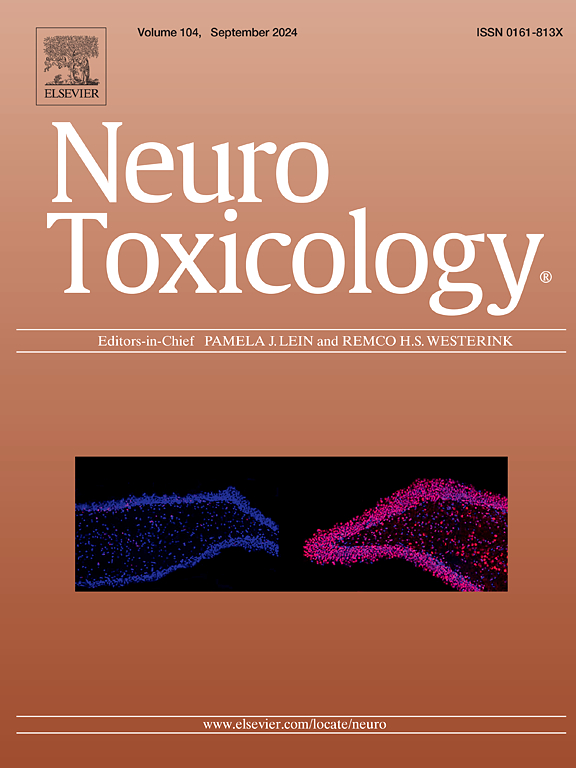PCB 37 (3,4, 4’-trichlorobiphenyl) increased apoptosis and modulated neuronal morphogenesis in primary rat cortical neuron-glia cocultures in a concentration-, sex-, age-, and CREB-dependent manner
IF 3.9
3区 医学
Q2 NEUROSCIENCES
引用次数: 0
Abstract
Higher-chlorinated (HC) polychlorinated biphenyls (PCBs) are known developmental neurotoxicants. In contrast, there are limited data regarding the developmental neurotoxicity of lower-chlorinated (LC) PCBs despite the increasing environmental prevalence and detection of LC-PCBs in contemporary human tissues, including the perinatal brain. This study characterized the neurotoxic effects of the LC-PCB congener PCB 37 in primary male and female rat cortical neuron-glia co-cultures. Cultures were exposed to varying concentrations of PCB 37 for 48 h beginning on day in vitro 0 or 7. Cell viability was assessed by measuring lactate dehydrogenase release into the culture medium and the percentage of live cells identified using Calcein-AM and Hoechst staining. Apoptosis was measured using fluorometric assays of caspase 3/7 activity and Annexin V binding. Axonal and dendritic growth were quantified in neurons immunostained for Tau-1 or transfected with MAP2B-red fluorescent protein, respectively, using automated image analysis protocols. At environmentally relevant concentrations (0.0001, 0.1, and 100 nM) that did not affect cell viability, PCB 37 caused sex-, age-, and concentration-dependent increases in apoptosis, axonal, and dendritic growth. Pretreatment with the CREB inhibitor 666–15 (500 nM) blocked the effects of PCB 37 on apoptosis and dendritic morphology but not axonal growth. These findings suggest that the pro-apoptotic and dendrite-promoting effects of PCB 37 are mediated by CREB signaling, but that CREB-independent mechanisms underlie PCB 37 effects on axonal growth. Overall, these findings identify PCB 37 as a potential developmental neurotoxicant and further support increasing evidence identifying CREB as a convergent mechanism of developmental neurotoxicity.
PCB 37(3,4,4 ' -三氯联苯)以浓度、性别、年龄和creb依赖的方式增加大鼠皮质神经元-胶质共培养的细胞凋亡和调节神经元形态发生
高氯(HC)多氯联苯(PCBs)是已知的发育神经毒物。相比之下,关于低氯多氯联苯的发育神经毒性的数据有限,尽管低氯多氯联苯在当代人体组织(包括围产期大脑)中越来越普遍和检测到。本研究表征了LC-PCB同系物PCB 37对原代雄性和雌性大鼠皮质神经元-胶质共培养的神经毒性作用。培养物在离体第0或7天开始暴露于不同浓度的PCB 37 48 h。通过乳酸脱氢酶释放到培养基中,以及Calcein-AM和Hoechst染色鉴定的活细胞百分比来评估细胞活力。凋亡通过caspase 3/7活性和Annexin V结合荧光测定。使用自动图像分析方案,分别对Tau-1免疫染色或map2b -红色荧光蛋白转染的神经元的轴突和树突生长进行量化。在不影响细胞活力的环境相关浓度(0.0001、0.1和100 nM)下,PCB 37引起细胞凋亡、轴突和树突生长的性别、年龄和浓度依赖性增加。CREB抑制剂666-15(500 nM)预处理可阻断PCB 37对细胞凋亡和树突形态的影响,但不能阻断轴突生长。这些发现表明,PCB 37的促凋亡和促进树突生长的作用是由CREB信号介导的,但PCB 37对轴突生长的影响是由CREB独立的机制介导的。总的来说,这些发现确定了PCB 37是一种潜在的发育性神经毒物,并进一步支持越来越多的证据表明CREB是发育性神经毒性的趋同机制。
本文章由计算机程序翻译,如有差异,请以英文原文为准。
求助全文
约1分钟内获得全文
求助全文
来源期刊

Neurotoxicology
医学-毒理学
CiteScore
6.80
自引率
5.90%
发文量
161
审稿时长
70 days
期刊介绍:
NeuroToxicology specializes in publishing the best peer-reviewed original research papers dealing with the effects of toxic substances on the nervous system of humans and experimental animals of all ages. The Journal emphasizes papers dealing with the neurotoxic effects of environmentally significant chemical hazards, manufactured drugs and naturally occurring compounds.
 求助内容:
求助内容: 应助结果提醒方式:
应助结果提醒方式:


